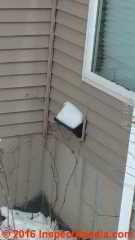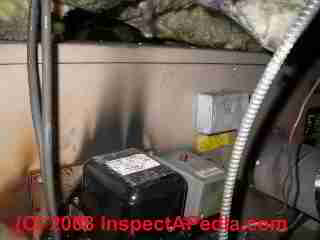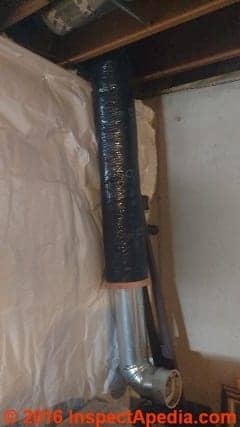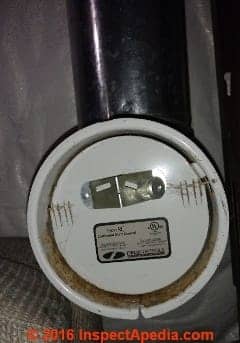 Power Vent Openings & Louvers for Combustion Air
Power Vent Openings & Louvers for Combustion Air
Safety Features on Powered Combustion Air Vents Avoid Combustion Air Problems
- POST a QUESTION or COMMENT about combustion air requirements and safety hazards for oil and gas fired heating appliances
Combustion air openings operated by power louvers or power vent opening mechanisms:
This article describes the requirements for safe operation & control of heating systems whose combustion air is provided by a powerd automatically-opening and closing louver or vent system. The article continues with photographs and comments on an un-safe home-made vent control intended to avoid cold drafts at the combustion air inlet.
This article series explains how to recognize and fix combustion air defects on heating appliances such as boilers, furnaces, and water heaters. These articles answer most questions about central hot water heating system troubleshooting, inspection, diagnosis, and repairs.
InspectAPedia tolerates no conflicts of interest. We have no relationship with advertisers, products, or services discussed at this website.
- Daniel Friedman, Publisher/Editor/Author - See WHO ARE WE?
Combustion Air Inlet by Automatically Operated Louvers or Dampers
 Watch out: inadequate combustion air not only causes improper and wasteful operation of heating equipment it can also produce fatal carbon monoxide gas hazards indoors. The quantity of combustion air needed depends on the fuel type, the input BTUh rating of the heating equipment, and additional air needed to assure effective exhaust draft to carry combustion products safely out of the building.
Watch out: inadequate combustion air not only causes improper and wasteful operation of heating equipment it can also produce fatal carbon monoxide gas hazards indoors. The quantity of combustion air needed depends on the fuel type, the input BTUh rating of the heating equipment, and additional air needed to assure effective exhaust draft to carry combustion products safely out of the building.
Question: louvered combustion air opening operating sequence
2016/06/22 Keith preddie said:
Can anyone go through the control sequence between louvered openings and the gas fired equipment?
Reply:
Keith, If I understand the question
- Thermostat calls for heat
- Motor-operated louvers open to supply combustion air to the bas burner
- An end switch should be present that does not allow the burner to turn on until the louvers are fully open (assuring that safe combustion air is provided)
- Burner operates
- Thermostat is satisfied
- Burner turns off
- Louvers close
Watch out: automatically operated combustion air louvers or dampers must meet specific safety requirements for wiring and burner control to assure that the burner doesn't fire if the air inlet is not open. If the louvered opening does not open fully as required before the burner starts, fatal carbon monoxide gas could be produced. And if the louvered opening doesn't close when it should cold or even freezing air can cause building damage or even loss of heat.
Air opening size for any combustion air supply inlet should meet the BTUH requirements of the equipment and follow the requirements of the
For gas equipment the full name of the standard is NFPA 54/ ANSI Z223.1, National Fuel Gas Code, for gas-fired boilers
Or the Standard for the Installation of Oil Burning Equipment, NFPA 31.
Fans supplying combustion air must be interlocked with the boiler as should be power-louvered controls over combustion air openings.
Also see ASME CSD-1 2009, Safety Controls and Devices for Automatically Fired Boilers
There paragraph CG-260, Combustion Air includes
(b) Louvers and grilles shall be fixed in the open position or interlocked with the equipment so that they are opened automatically during equipment operation. The interlock shall be placed on the driven member.
See the model code specifications for combustion air inlets cited at COMBUSTION AIR for POWER BURNERS
Combustion Air Inlets vs Cold Drafts
Reader Question: fixing cold drafts coming in at the natural gas furnace combustion air inlet set up by my contractor
[Click to enlarge any image]
2016/04/02 Doug said:
I have a NG forced air furnace and a NG fireplace in my 2004 built home in the WNY area. I have a independent draft regulator venting into my basement. I do not understand why I need this? My understanding at the time by the home builder was that he builds "airtight" homes and that's why I need it.
Fact is my house is far from "airtight", and this vent is on the windy side of my home and this vent allows a steady stream of cold air into my basement making it quite cold threw the winter months. I am planning a basement finishing project know and want to eliminate the source of the cold air. Just curious what the ramifications may be. I do have photos, but this comment section doesn't seem to allow :(
This question was posted originally
at DRAFT REGULATOR, DAMPER, BOOSTER
Reply: home made combustion air supply systems may be unsafe
Doug:
If a gas-fired heating appliance does not have adequate combustion air it can produce fatal levels of carbon monoxide. The draft-hood on your natural gas furnace regulates the draft but does not provide combustion air to the furnace.
Your heating service tech can check your system operation, location, burner adjustment, flue draft, size of the area where it's located, and similar specs and can compare those with the manufacturer's requirements to be sure there is adequate combustion air.
I agree that if the area where the furnace is located is big enough or receives enough natural ventilation and combustion air, you may not need the extra air source.
See inspectapedia.com/heat/Combustion_Air_Requirements.php found by searching InspectApedia.com for COMBUSTION AIR REQUIREMENTS
You are welcome to send us photos via the page bottom CONTACT link.
Reader followup:
Thanks for the valuable information. I did send my photos per your link for your edification.
Reply:
Doug:
This looks like a home-made jury-rigged combustion air inlet for heating equipment. It looks as if there is a dryer vent, flex duct, and a barometric damper used (backwards) - I can't understand how that setup would work. And even what's there is not correctly installed: both in application, sizing, and installation (out of level).
Usually a Field Controls draft regulator like the one in your photos vents OUT through its opening face, not in to the room where your set-up is shown.
You'll want to see the article I cited above and also COMBUSTION AIR for TIGHT BUILDINGS
One can't guess at what your equipment needs from just those photos (the articles explain the basics of how to figure that out). But it seems unlikely that a clothes dryer vent sized intake provides a meaningful amount of combustion air anyway.
If your heating appliances do not have enough combustion air without ducting in outdoor air, there are systems that will duct the air right to each burner where it's needed, avoiding creating a chilly draft across the floor of the same spaces.
Watch out: inadequate combustion air supply to gas fired heating appliances risks fatal carbon monoxide poisoning.
...
Continue reading at COMBUSTION AIR SAFETY CHECK or select a topic from the closely-related articles below, or see the complete ARTICLE INDEX.
Or see these
Recommended Articles
- BACKDRAFTING HEATING EQUIPMENT
- COMBUSTION AIR for TIGHT BUILDINGS
- COMBUSTION AIR REQUIREMENTS
- CLUES INDICATING INADEQUATE COMBUSTION AIR
- COMBUSTION AIR DEFECTS
- COMBUSTION AIR DEFECT EFFECTS
- COMBUSTION AIR RULES of THUMB
- COMBUSTION AIR vs ROOM SIZE
- COMBUSTION AIR DUCT SIZE vs BTUh
- COMBUSTION AIR for POWER BURNERS
- COMBUSTION AIR INLET AUTOMATIC LOUVERS
- COMBUSTION AIR INLETS vs COLD DRAFTS
- COMBUSTION AIR REQUIREMENTS
- COMBUSTION AIR SAFETY CHECK
- COMBUSTION AIR SAFETY in MOBILE HOMES
- COMBUSTION AIR for TIGHT BUILDINGS
- COMBUSTION AIR for WOODSTOVES
- UN-VENTED GAS HEATER SAFETY
Suggested citation for this web page
COMBUSTION AIR INLET AUTOMATIC LOUVERS at InspectApedia.com - online encyclopedia of building & environmental inspection, testing, diagnosis, repair, & problem prevention advice.
Or see this
INDEX to RELATED ARTICLES: ARTICLE INDEX to HEATING SYSTEMS
Or use the SEARCH BOX found below to Ask a Question or Search InspectApedia
Ask a Question or Search InspectApedia
Questions & answers or comments about combustion air requirements and safety hazards for oil and gas fired heating appliances
Try the search box just below, or if you prefer, post a question or comment in the Comments box below and we will respond promptly.
Search the InspectApedia website
Note: appearance of your Comment below may be delayed: if your comment contains an image, photograph, web link, or text that looks to the software as if it might be a web link, your posting will appear after it has been approved by a moderator. Apologies for the delay.
Only one image can be added per comment but you can post as many comments, and therefore images, as you like.
You will not receive a notification when a response to your question has been posted.
Please bookmark this page to make it easy for you to check back for our response.
IF above you see "Comment Form is loading comments..." then COMMENT BOX - countable.ca / bawkbox.com IS NOT WORKING.
In any case you are welcome to send an email directly to us at InspectApedia.com at editor@inspectApedia.com
We'll reply to you directly. Please help us help you by noting, in your email, the URL of the InspectApedia page where you wanted to comment.
Citations & References
In addition to any citations in the article above, a full list is available on request.
- American Society of Heating, Refrigerating and Air-Conditioning Engineers (ASHRAE) Handbook - Fundamentals, 1993, Chapter 15, page 15.9 Air For Combustion.
- ASME CSD-1- Controls and Safety Devices for Automatically Fired Boilers, 1992 with addendum 1a 1993. section CG-260 Combustion Air.
- BOCA - National Mechanical Code, 1990, article 10, Combustion Air.
- NFPA 31 - Installation of Oil Burning Equipment, 1992, section 1-5 Air for Combustion and Ventilation.
- NFPA 54: National Fuel Gas Code (2015), addresses heating appliance combstion air ventilation specifications. NFPA 54, ANSI Z223.1 provides minimum safety requirements for the design and installation of fuel gas piping systems in homes and other buildings.
- NFPA 85: Boiler and Combustion Systems Hazards Code: NFPA 85 contributes to operating safety and prevents explosions and implosions in boilers with greater than 12.5 MMBTUH, pulverized fuel systems, and heat recovery steam generators.
- NFPA 87: Recommended Practice for Fluid Heaters, This recommended practice provides safety guidance for fluid heaters and related equipment to minimize fire and explosion hazards that can endanger the fluid heater, the building, or personnel
- SBCCI- Standard Mechanical Code, 1991, section 305 Combustion and Ventilation Air.
- Axtman, William H., "Combustion Air Requirements: The Forgotten Element in Boiler Rooms", Grayh Gull Associates, retired executive director of the American Boiler Manufacturers Association, National Board Technical Series, Winter 1995 National Board Bulletin. Retrieved 26 January 2015, original source: http://www.nationalboard.org/index.aspx?pageID=164&ID=191
Excerpt:
Several safety codes such as the National Fire Protection Association's standards, NFPA 54 - National Fuel Gas code, NFPA 31 - Installation of Oil Burning Equipment, and the American Society of Mechanical Engineers (ASME) CSD-l Controls and Safety Devices for Automatically Fired Boilers have sections covering the requirements for combustion air intakes. In addition, building codes such as the Building Officials and Code Administrators International (BOCA) National Mechanical Code and the Standard Mechanical Code published by the Southern Building Code Congress International (SBCCI) have air requirements for combustion.
Editor's note: Some ASME Boiler and Pressure Vessel Code requirements may have changed because of advances in material technology and/or actual experience. The reader is cautioned to refer to the latest edition and addenda of the ASME Boiler and Pressure Vessel Code for current requirements. - Nussbaumer, Thomas. "Combustion and co-combustion of biomass: fundamentals, technologies, and primary measures for emission reduction." Energy & fuels 17, no. 6 (2003): 1510-1521.
- Utiskul, Yunyong P., Wu, Neil P., Biteau, Hubert, "Combstion Air Requirements for Power Burner Appliances, Final Report", The Fire Protection Research Foundation, The Fire Protection Research Foundation
One Batterymarch Park
Quincy, MA, USA 02169-7471
Email: foundation@nfpa.org
http://www.nfpa.org/foundation, retrieved 25 Jan 2015, original source: http://www.nfpa.org/~/media/files/research/research%20foundation/rfcombustionairrequirements.ashx, Executive Summary:
Gas-fired appliances require combustion air to properly function. Adequate air is necessary for
supporting combustion of the appliance burner, dilution of flue gas, and proper ventilation of the
space where the appliance is installed. Current standards and model codes outline requirements
and methods to supply the combustion air. One method is to provide outdoor combustion air
through openings or air ducts communicating with the outdoors through natural ventilation.
Most standards require the outdoor opening(s) be prescriptively sized based on the total energy
input rating of the appliance. However, in the United States, the current standards contain no
separate provisions to address the opening size supplying the combustion air for
commercial/industrial sized appliances, which typically have a high energy input rating of
greater than 300 kBtu/hr and are equipped with a power burner unit. As a result, the opening(s)
can be excessively sized when determined based on the current standards.
This research project establishes minimum outdoor combustion air requirements specific to gasfired
appliances utilizing power burners with input ratings no greater than 12.5 MBtu/hr. A
review of the available literature, engineering guidelines, and current standards and model codes
related to combustion air requirements was performed. This report provides an understanding
of the technical basis for the existing provisions for combustion air and their applicability to
power burner appliances. This report also identifies the range of energy input ratings for gasfired
appliances equipped with power burners, and compares the combustion air requirements
specified by a range of appliance manufacturers. A theoretical model for air flow through
openings was developed and the modeling results, together with the data gathered through the
literature review, were used to provide a baseline to establish the theorized combustion air
requirements suitable for power burner appliances.
... - [1] Jeff Wilcox, "Evaluating Duct Work, How to Evaluate Furnace Duct Work & Cure Short Cycling or Inadequate Ductwork Problems" Vermont Department for Children and Families, Office of Economic Opportunity, - dcf.vermont.gov/sites/dcf/files/pdf/oeo/WAPManual/AppendixI.pdf retrieved 12/5/2013. Geoff Wilcox Vermont Office of Economic Opportunity Weatherization Assistance Program Waterbury, VT (802) 769-8376 Geoff.wilcox@state.vt.us Reference Material for the original article came from: 1. Saturn Mechanical Systems Field Guide 2. Bacharach (Rudy Leatherman)
- Field Controls provides instructions for the installation of LP and Natural Gas spill sensor switches, for example for their Gas Spillage Sensing Kit Model GSK-3, GSK-4, GSK-250M switches. Contact your heating service technician directly, or contact Field controls at fieldcontrols.com for more information. These switch models include a manual reset switch. Field Controls, Kingston NC 28504 - Tel 252-522-3031.
- Tjernlund Products provides instructions for the installation and use of their controls, including the WHKE Millivolt Interlock Kit for use with their UC1 Universal Control, MAC1E or MAC4E auxiliary controls for gas fired equipment. This document also describes Tjernlund's recommended combustion air safety check which we recommended in this article. Contact Tjernlund Products at tjernlund.com or at 800-255-4208.
- Bachrach Corporation, www.bachrach-training.com provides education for HVAC technicians. We found their web pages hanging during loading -01/2009. Readers may want to contact the company directly at: bacharach-inc.com or at 800-736-4666.
- R.E. Prescott Company, a producer of other REPCO™ residential and industrial products as well as a provider of design-build engineering services is at 10 Railroad Avenue, Exeter, NH 03833. Tel: 603-722-04321 or 888-786-7482. Trish O'Keefe from Prescott informed us (10/7/2009) that their company had nothing to do with the failed Repco heating boilers discussed at InspectAPedia.com.
- Our recommended books about building & mechanical systems design, inspection, problem diagnosis, and repair, and about indoor environment and IAQ testing, diagnosis, and cleanup are at the InspectAPedia Bookstore. Also see our Book Reviews - InspectAPedia.
- Domestic and Commercial Oil Burners, Charles H. Burkhardt, McGraw Hill Book Company, New York 3rd Ed 1969.
- National Fuel Gas Code (Z223.1) $16.00 and National Fuel Gas Code Handbook (Z223.2) $47.00 American Gas Association (A.G.A.), 1515 Wilson Boulevard, Arlington, VA 22209 also available from National Fire Protection Association, Batterymarch Park, Quincy, MA 02269. Fundamentals of Gas Appliance Venting and Ventilation, 1985, American Gas Association Laboratories, Engineering Services Department. American Gas Association, 1515 Wilson Boulevard, Arlington, VA 22209. Catalog #XHO585. Reprinted 1989.
- The Steam Book, 1984, Training and Education Department, Fluid Handling Division, ITT [probably out of print, possibly available from several home inspection supply companies] Fuel Oil and Oil Heat Magazine, October 1990, offers an update,
- Principles of Steam Heating, $13.25 includes postage. Fuel oil & Oil Heat Magazine, 389 Passaic Ave., Fairfield, NJ 07004.
- The Lost Art of Steam Heating, Dan Holohan, 516-579-3046 FAX
- Principles of Steam Heating, Dan Holohan, technical editor of Fuel Oil and Oil Heat magazine, 389 Passaic Ave., Fairfield, NJ 07004 ($12.+1.25 postage/handling).
- "Residential Steam Heating Systems", Instructional Technologies Institute, Inc., 145 "D" Grassy Plain St., Bethel, CT 06801 800/227-1663 [home inspection training material] 1987
- "Residential Hydronic (circulating hot water) Heating Systems", Instructional Technologies Institute, Inc., 145 "D" Grassy Plain St., Bethel, CT 06801 800/227-1663 [home inspection training material] 1987
- "Warm Air Heating Systems". Instructional Technologies Institute, Inc., 145 "D" Grassy Plain St., Bethel, CT 06801 800/227-1663 [home inspection training material] 1987
- Heating, Ventilating, and Air Conditioning Volume I, Heating Fundamentals,
- Boilers, Boiler Conversions, James E. Brumbaugh, ISBN 0-672-23389-4 (v. 1) Volume II, Oil, Gas, and Coal Burners, Controls, Ducts, Piping, Valves, James E. Brumbaugh, ISBN 0-672-23390-7 (v. 2) Volume III, Radiant Heating, Water Heaters, Ventilation, Air Conditioning, Heat Pumps, Air Cleaners, James E. Brumbaugh, ISBN 0-672-23383-5 (v. 3) or ISBN 0-672-23380-0 (set) Special Sales Director, Macmillan Publishing Co., 866 Third Ave., New York, NY 10022. Macmillan Publishing Co., NY
- Installation Guide for Residential Hydronic Heating Systems
- Installation Guide #200, The Hydronics Institute, 35 Russo Place, Berkeley Heights, NJ 07922
- The ABC's of Retention Head Oil Burners, National Association of Oil Heat Service Managers, TM 115, National Old Timers' Association of the Energy Industry, PO Box 168, Mineola, NY 11501. (Excellent tips on spotting problems on oil-fired heating equipment. Booklet.)
- In addition to citations & references found in this article, see the research citations given at the end of the related articles found at our suggested
CONTINUE READING or RECOMMENDED ARTICLES.
- Carson, Dunlop & Associates Ltd., 120 Carlton Street Suite 407, Toronto ON M5A 4K2. Tel: (416) 964-9415 1-800-268-7070 Email: info@carsondunlop.com. Alan Carson is a past president of ASHI, the American Society of Home Inspectors.
Thanks to Alan Carson and Bob Dunlop, for permission for InspectAPedia to use text excerpts from The HOME REFERENCE BOOK - the Encyclopedia of Homes and to use illustrations from The ILLUSTRATED HOME .
Carson Dunlop Associates provides extensive home inspection education and report writing material. In gratitude we provide links to tsome Carson Dunlop Associates products and services.



